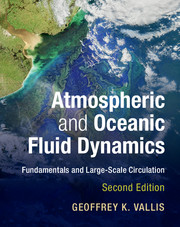Book contents
- Frontmatter
- Dedication
- Contents
- Preface
- Notation
- PART I FUNDAMENTALS OF GEOPHYSICAL FLUID DYNAMICS
- PART II WAVES, INSTABILITIES AND TURBULENCE
- PART III LARGE-SCALE ATMOSPHERIC CIRCULATION
- 14 The Overturning Circulation: Hadley and Ferrel Cells
- 15 Zonally-Averaged Mid-Latitude Atmospheric Circulation
- 16 Planetary Waves and Zonal Asymmetries
- 17 The Stratosphere
- 18 Water Vapour and the Tropical Atmosphere
- PART IV LARGE-SCALE OCEANIC CIRCULATION
- References
- Index
15 - Zonally-Averaged Mid-Latitude Atmospheric Circulation
from PART III - LARGE-SCALE ATMOSPHERIC CIRCULATION
Published online by Cambridge University Press: 09 June 2017
- Frontmatter
- Dedication
- Contents
- Preface
- Notation
- PART I FUNDAMENTALS OF GEOPHYSICAL FLUID DYNAMICS
- PART II WAVES, INSTABILITIES AND TURBULENCE
- PART III LARGE-SCALE ATMOSPHERIC CIRCULATION
- 14 The Overturning Circulation: Hadley and Ferrel Cells
- 15 Zonally-Averaged Mid-Latitude Atmospheric Circulation
- 16 Planetary Waves and Zonal Asymmetries
- 17 The Stratosphere
- 18 Water Vapour and the Tropical Atmosphere
- PART IV LARGE-SCALE OCEANIC CIRCULATION
- References
- Index
Summary
THE FOCUS OF THIS CHAPTER is the zonally-averaged structure and circulation of the extratropical troposphere. Because of the presence of strong zonal asymmetries — in particular baroclinic eddies or, more simply, the weather — this circulation differs markedly from the zonally symmetric circulation that would exist if eddies did not develop at all. The angularmomentum- conserving model of the Hadley Cell discussed in Chapter 14 is an example of a zonally-symmetric circulation, but this may be quite different from the zonally-averaged circulation in a turbulent atmosphere. Let us explain more.
When studying some aspects of the large-scale ocean circulation, or the low-latitude atmospheric circulation, we can make a great deal of progress by treating the large-scale flow as if it were absolutely steady with the eddies having only a perturbative effect. However, this approach fails badly for the mid-latitude atmosphere: the large-scale mid-latitude circulation is intrinsically unsteady on the large-scale to the extent that the associated eddies essentially are the circulation. The eddies are also unpredictable and chaotic; that is to say, the large-scale mid-latitude circulation of the atmosphere is a turbulent flow. This turbulence involves large-scale, geostrophically and hydrostatically balanced flow — that is, it is geostrophic turbulence — and so has different properties than the smaller-scale, more nearly three- dimensional turbulence that may occur in boundary layers and the like. Further, this large-scale turbulence (sometimes called ‘macro-turbulence’) is neither fully-developed nor isotropic — it interacts with the Rossby waves that arise from the planetary rotation and might be regarded as a form of weak turbulence. Why is the large-scale flow turbulent? Why is it zonally asymmetric at all? There are two potential sources for zonal asymmetries:
(i) The zonal asymmetries that exist in the underlying boundary conditions and forcing: mountains, land–sea contrasts, the diurnal cycle, and so on.
(ii) Hydrodynamic instability: even if the surface and the forcing were exactly zonally symmetric, the corresponding zonally symmetric solutions of the equations of motion would have a large shear in the zonal wind and this might be baroclinically unstable to zonally asymmetric perturbations.
If the flow were not unstable, then we might expect that the zonal asymmetries of item (i) would give rise to corresponding, steady, zonal asymmetries in the resulting circulation, and this process is discussed in the next chapter.
- Type
- Chapter
- Information
- Atmospheric and Oceanic Fluid DynamicsFundamentals and Large-Scale Circulation, pp. 539 - 584Publisher: Cambridge University PressPrint publication year: 2017



